|
|

| Bulgarian Historic Snapshot |
|
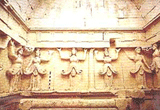 |
Before The Bulgarian State
The first known civilization to
dominate the territory of present-day Bulgaria was that of the
Thracians, an Indo-European group. Although politically fragmented,
Thracian society is considered to have been comparable to that of
Greece in the arts and economics; these achievements reached a peak
in the sixth century B.C. Because of political disunity, however,
Thrace then was successively occupied and divided by the Greeks, the
Persians, the Macedonians, and the Romans. After the decline of the
Macedonian Empire of Alexander the Great, a new Thracian kingdom
emerged in the third century B.C. Occupied by the Romans, it
remained a kingdom within the Roman Empire until the emperor
Vespasian incorporated it as a district in the first century A.D.
Roman domination brought orderly administration and the
establishment of Serditsa (on the site of modern Sofia) as a major
trading center in the Balkans. In the fourth century A.D., when the
Roman Empire split between Rome and Constantinople, Thrace became
part of the Eastern, or Byzantine, Empire. Christianity was
introduced to the region at this time. Both the Latin culture of
Rome and the Greek culture of Constantinople remained strong
influences on ensuing civilizations. |
|
|
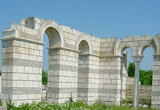 |
First Bulgarian Kingdom
Bulgaria emerged and received official recognition following two victories over the cosmopolitan Byzantine empire. The first battles took place in the Danube delta area in the year 680 A.D. The conflicts continued in the following year, spreading south of the Balkan Range. This is cited in the Acts of the Sixth Oecumenical Council of the Christian Church in Constantinople (present-day Istanbul).
This council, over the course of almost a year, debated and asserted - in opposition to the monothelitic heresy - the official thesis that Christ had two wills, one divine and the other human.
On March 18th, 681, the Byzantine emperor Constantine IV Pagonatus departed from the Council to curb the incursions of the Proto-Bulgarians into Thrace, which violated the wholeness of the empire. But he failed to break their dauntless will and strength. The sixteenth sitting of the Council took place on August 9th of the same year and this is how presbyter Constantine of Apameia in Second Syria addressed the Council: 'I have come to your holy council to tell you that if I had been let to come and speak, we should have suffered what we have been through in the war with the Bulgarians. Because I wanted, from the very beginning of this council, to come and ask that peace be made, so that something be done to unite the two sides, and either be spared the misery, that is to say, both those who preach the single will and those who uphold the two wills'. It is asserted on the basis of this source that the decisive event occurred not earlier than March 18th and no later than August 9th of The year 681.
The First Bulgarian Empire was able to defeat the Byzantine Empire in 811 and expand its territory eastward to the Black Sea, south to include Macedonia, and northwest to present-day Belgrade. The kingdom reached its greatest size under Tsar Simeon (893-927), who presided over a golden age of artistic and commercial expansion. After moving deep into Byzantine territory, Simeon was defeated in 924.
Meanwhile, Rome and Byzantium competed for political and cultural influence in Bulgaria. The Eastern Empire won in 870 when Bulgaria accepted Eastern Rite (Orthodox) Christianity and an autocephalous Bulgarian Church was established. This decision opened Bulgaria to Byzantine culture (and territorial ambitions) through the literary language devised for the Slavs by the Orthodox monks Cyril and Methodius. Establishment of a common, official religion also permanently joined the Bulgarian and Slavic cultures.
After reaching its peak under Simeon, the First Bulgarian Empire declined in the middle of the tenth century. Byzantine opposition and internal weakness led to a loss of territory to the Magyars and the Russians. Bulgaria remained economically dependent on the Byzantine Empire, and the widespread Bogomil heresy opposed the secular Bulgarian state and its political ambitions as work of the devil. Seeking to restore a balance of power in the Balkans, the Byzantines allied with the Kievan Russians under Yaroslav and invaded Bulgaria several times in the late tenth century. Although the Bulgarians expanded their territory again briefly under Tsar Samuil at the end of the tenth century, in 1014 the Byzantines under Basil II inflicted a major military loss. By 1018 all of Bulgaria was under Byzantine control. For nearly two centuries, the Byzantines ruled harsh
|
|
|
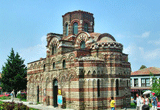 |
Second Bulgarian Kingdom By 1185 the power of the
Byzantine Empire again waned because of external conflicts. The
noble brothers Asen and Peter led a revolt that forced Byzantine
recognition of an autonomous Bulgarian state. Centered at Turnovo
(present-day Veliko Turnovo), this state became the Second Bulgarian
Empire. Like the First Bulgarian Empire, the second expanded at the
expense of a preoccupied Byzantine Empire. In 1202 Tsar Kaloian
(1197-1207) concluded a final peace with Byzantium that gave
Bulgaria full independence. Kaloian also drove the Magyars from
Bulgarian territory and in 1204 concluded a treaty with Rome that
consolidated Bulgaria's western border by recognizing the authority
of the pope. By the middle of the thirteenth century, Bulgaria again
ruled from the Black Sea to the Adriatic. Access to the sea greatly
increased commerce, especially with the Italian Peninsula. Turnovo
became the center of Bulgarian culture, which enjoyed a second
golden age.
The final phase of Bulgaria's second Balkan dominance was the reign
of Kaloian's successor, Ivan Asen II. In this period, culture
continued to flourish, but political instability again threatened.
After the death of Ivan Asen II, internal and external political
strife intensified. Sensing weakness, the Tatars began sixty years
of raids in 1241, the Byzantines retook parts of the Second
Bulgarian Empire, and the Magyars again advanced. From 1257 until
1277, aristocratic factions fought for control of the Bulgarian
throne. Heavy taxation by feudal landlords caused their peasants to
revolt in 1277 and enthrone the "swineherd tsar" Ivailo. After 1300
Tatar control ended, and a new period of expansion followed under
Mikhail Shishman (1323-1330) and Ivan Aleksandur (1331-1370). As
before, however, military and commercial success paralleled internal
disorder; the social chaos of the previous century continued to
erode the power of Bulgarian leaders. Meanwhile, Serbia had risen as
a formidable rival in the Balkans, and the Ottoman Turks had
advanced to the Aegean coast. In the late fourteenth century,
Bulgaria was weakened by the division of its military defenses
between the two perceived threats.
|
|
|
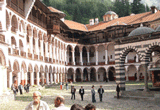 |
Under Foreign Control The pre-history of the
Ottoman Turks (after the name of the dynasty of their first ruler
Osman), proceeded for centuries in Central Asia. Driven out of there
by the Mongolian-Tartars, according to some sources in the 13th
century they, numbering about 50,000, settled within the borders of
the ephemerial and disintegrating nomadic empire of the Seljuks to
whom they were related. Their small Islamic state in north-western
Anatolia swelled rapidly at the expense of the Byzantine territories
in Asia Minor a large part of whose population they succeeded in
assimilating. Instead of storming Constantinople as many of their
predecessors had done, they went round it and set foot on the Balkan
Peninsula in the middle of the 14th century (immediately after the
plague epidemic that had raged in the whole of Europe, decimating
two thirds of the population in some western countries). After
gaining a foothold in the Balkans, they made Edirne their capital.
That was a real threat to the population of the peninsula and they
put up stubborn resistance. It was after fifty years of constant
attacks and bloodsheds coupled with stratagems and combinations vis-a-
vis the disunited feudal rulers that they conquered Bulgaria and
headed west. Meanwhile, they seized Constantinople in 1453 and made
it their capital. The fact that Suleiman the Magnificent (1520-1566)
considered himself successor to the emperors of the Eastern Roman
Empire and proclaimed himself Caesar was evidence of their growing
appetites. Their campaigns of conquest in the west were stopped at
the gates of Vienna. Thus Bulgarians, Greeks, Serbs, Albanians,
Ukrainians, Armenians and Arabs remained in Ottoman bondage for
several centuries. After taking Egypt and Syria in 1517, the Sultans
also assumed the title of caliphs.
During the fall of Constantinople the representatives of the
clerical elite of the Byzantine Empire headed for the West taking
along valuable ancient literature. Because the Ottoman Empire had
imposed control over what were until then considered traditional sea
and land merchant routes to the Asian continent, the search for new
routes was encouraged in the Western countries. What was achieved
surpassed all expectations: a new continent was discovered, a new
route to India was found and there appeared colonial empires of a
capitalist type whose expansion was also in the direction of the
Ottoman empire.
What remained from the long rule of the Ottoman sultans was the
memory of the education system (medreses) that fettered the
spiritual development of their people, of the atrocities committed
by them and the wars that followed one another as well as of the
many tax registers (unlike the Arab caliphs, for example, who also
ruled over part of Spain for seven centuries, and of the Great
Mongols who ruled over part of India for nearly a century, but
patronized the sciences and the arts and encouraged and facilitated
the establishment of important cultural centres). The resources
obtained from the Vassal States enabled the Ottoman upper crust to
keep their own people in obedience and patriarchal oriental
backwardness. The decline of the empire was precipitated by the
national- liberation movements of the peoples ruled by them as well
as by the series of Russo-Turkish wars. As a result of the
successful antiimperialist lit)eration movement headed by, Kemal
Ataturk, the modern Repeblic of Turkey was founded.
On the eve of the Ottoman occupation, the population of Bulgaria
split into two kingdoms and two independent feudal areas, numbered,
according to rough estimates, about 2,500,000 people. It is assumed
that immediately after the establishment of Ottoman power it was
reduced by half - some part of the Bulgarians perished in the course
of the war, others were taken captive and sold in slavery.
From the fifteenth to the eighteenth century the Bulgarian
population, which was composed primarily of peasants, was placed in
the conditions of feudal oppression much graver than in previous
times. The land was regarded as the property of the supreme ruler,
the Sultan, who distributed it among his subordinate administrators
(judges), war veterans and servicemen of the reserve, and to the
so-called spahi - regular servicemen all of whom were granted the
rights of feudal landowners for life. It was the duty of the landed
officers and servicemen to report in times of war in full battle
trim at the places of muster in various districts (sandjaks).
The Bulgarian lands became part of the region governed by
theRoumelibeilerbei with a seat first in the town of Edirne and
later in Sofia, including the Balkan provinces of the Ottoman
Empire. The lands with a predominantly Bulgarian population were
covered (in wholeor in part) by the sandjaks of Silistra, Nikopol,
Vidin, Pasha (the regions of Edirne, Elhovo and Plovdiv), Chirmen
(the Sub-Balkan valley), Kyustendil, Ohrid and Sofia. The Bulgarian
Patriarchate was abolihed; the Christian Bulgarians were
subordinated toan alien church, i.e. the Constantinople Patriarch,
who appointed mainly Greeks to Bulgarian bishoprics.
The Ottoman military-feudal system was influenced by Arab, Persian,
Turkic, Mongolian and Byzantine political practices. This system of
government headed by the sultan (the padishah) accorded primary role
to the estste of the ulems (theologians and legislators upholding
theocracy). Overcoming duality in the political structure and the
unification of these two forces into a unitary system of the "realm
of the faith" was achieved through the proclamation of the sultan as
"Allah's shadow on Earth" and by including most of the ulems into
the state apparatus. Unity and centralization in the large empire
was maintained mainly by extra-economic methods, primarily through
highly developed socio-political institutions. Prime importance was
accorded to Islam (the word means obedience, submissiveness) - to
that last offshoot of monotheism which had become a world religion.
The Ottomans claimed that it was they who spread the pure, orthodox
so called Sunni Islam contrary to the Shiite branch of Islam which
had estahlished itself in Iran. (By this,they also justified their
numerous conflicts with Iran in the 16th and 17th centuries). As the
Soviet scholar of Ottoman Turkey M. S. Mayer points out, the sultans
"devoted a great deal of attention to the spreading of the Muslim
religion in the newly conquered European territories, both by
forcible Islamization of the population and by creating numerous
faith-propagating centres (imarets) on the basis of vakif property".
The aim was to inculcate obedience and submissiveness to the supreme
authority, given the existing economic fragmentariness and ethnic
and religious diversity of the subjects in the Empire. Naturally,
the results of these efforts fell far short of expectations. It was
a system under which the central authorities were mainly interested
in the efficient functioning of the fiscal institutions.
Every one of the feudal lords in the Empire was entitled to a
portion of the incomes of his subordinate households and the fees on
the issued certificates (tapis) through which the households
acquired plots of land (the fee equalled half of the yearly revenue
from the land). The "owners" thus bound to the soil had to conform
to the preferences of the lord as to what to plant on the soil and
had no right to leave their feudal lord.
The service feudal estates (spahiliks) in many respects resembled
the Byzantine pronia. Naturally, the Ottoman system of land
ownership sustained substatial transformations, especially at the
turn of the 19th century when in the regions suitable for industrial
crops new estates called cifliks were formed. They were subject to
lawful sale and purchase, could employ hired labour and produced
crops for the market (e.g. in north-western Bulgaria, in the
Macedonia area and in Thrace). That was a process similar to the
"enclosures" in 16th and 17th century England as a result of which
the land was expropriated from the peasants who became hired hands
to the new owners or joined the urban plebs.
In any case, the Ottoman state developed best those of its functions
which most helped plunder the population. The heaviest tax collected
by the state from the non-Muslim people was the poll-tax (ciziye).
Every non-Muslim from the age of 15 to 75 had to pay only for
figuring in the lists of the Sultan's subjects (such lists were made
once in 30 years). According to a 1736 decree, the wealthier
Christians paid 10 grosh each, the middling ones - 5 grosh and the
poorer ones - 2.5 grosh (one grosh at that time bought 13 loaves of
bread of 750 g each).
The local lord was paid by the non-Muslim households a land tax (ispenc
) which was greater than the tax owed by a Muslim household on the
same size of land. Another regular obligation of the raya (subjects)
towards the feudal lord was the tithe on the produce of the land (usur)
- between 1/10 and 1/8 of the yield.
These were the main taxes which were systematically infringed, i.e.
they were arbitrarily increased by their collectors, to say nothing
of various other levies, fees, fenes and corvee, extraordinary taxes
during military campaigns which subsequently became permanent and
which burdened the non-Muslim population. In addition to this
economic pressure, there were regular campaigns of Islamizing the
Bulgarian people by force, especially in the Rhodopes and in
Northern Bulgaria. A particularly cruel form of oppression was the
blood tax (devsirme), levied periodically from the 15th to the 18th
century. The Bulgarian families were forced to give up their best
male children who were then Turkified and educated in exceptional
Muslim fanaticism. They made up the janissary corps and became the
mainstay of the Ottoman authorities. Other forms of assimilation
included abductions of Christian women who were forced to become
wives and mothers of Muslims, the forcible re-settlement of
Bulgarians in Anatolia, physical extermination, etc.
Under these conditions, the Bulgarians found refuge-particularly in
the initial centuries of Ottoman domination-in their traditional
commune and also in the local cloister, newly-built or remaining
from the past age. Although their state had been abolished and they
themselves were reduced to living in primitive conditions, the
Bulgarians succeeded in preserving themselves as a nationality. The
more stouthearted resorted to armed resistance, fleeing into the
mountains. From acts of personal revenge, the haidout movement of
rebels became a means of collective self-defence. There were also
periodic rebellions and insurrections.
The campaigns against the Ottomans by the rulers of certain Central
European states sparked off armed unrest among the Bulgarians but
failed to bring about the expected change in the state of affairs.
However, it was Russia who became the mainstay of the Balkan
Christian population, the Bulgarians included. (By the end of the
15th century Russia had already freed itself from Tartar
domination).
Cultural and political links between the Bulgarian people and Russia
were restored during the 16th century, when the Moscow kingdom had
come to stay as the only large, independent state where the Eastern
Orthodox religion had survived and struck roots as the official
religion. In the words of Priest Philotey of Pskov after the Turks
conquered Constantinople, i.e. after 1453, Moscow became the third
Rome, 'and a fourth there will never be'. The legendary myth of
'grandfather Ivan' as the personification of protective Russia was
widespread among the Bulgarians. The Russo-Turkish wars of the 18th
and 19th centuries, some of which were fought on Bulgarian soil,
helped confirm the credibility of this legend.
All along economy had forged ahead. Through trade and finance the
Ottoman empire worked its way into the Western European economy.
European merchandise appeared on the markets of the empire and ports
were built for the export of farm products to Western and Central
Europe. Many Bulgarians were engaged in this area of trade.
The changes affected the rural areas too, leading to somewhat easier
living circumstances. A great number of peasants migrated to the
towns, where the Bulgarian element was beginning to gain dominance.
The Bulgarians, quick at learning commerce and mastering the crafts,
formed their own trade guilds, which had a large membership. The
husiness section of the Bulgarians was coming to the fore. Well-off
Bulgarians became the proprietors of trading firms, in import and
export of goods, organized large-scale stock-breeding or took over
the collection of state taxes. The Bulgarians did brisk business on
the markets in Central Europe (Hungary, Poland, Walachia and Russia)
where full-fledged colonies of Balkan and Bulgarian merchants sprang
up.
At home the Bulgarian townfolk competed with the Greeks and the
Walachians for business. The Bulgarian side of the competition was
supported hy the peasantry, which was suffering under the arbitrary
taxation policy of the Constantinople patriarchy, which controlled,
in addition to the Church, the Bulgarian schools where instruction
was given in Greek. The Bulgarians longed to exterminate the Greek
language and influence in the Bulgarian church, schools and public
life. The most outstanding exponent of such endeavours was Father
Paissi of Hilendar (1722 - 1773). He himself came from a village
(Bansko, present-day Blagoevgrad district), whose craftsmen and
merchants were competing with the Greeks both on the domestic and
Austrian markets. Being familiar with the Greek and Serbian national
movements (they developed, for a number of reasons, earlier than the
Bulgarian) he sat down and wrote a small book called 'Slav-Bulgarian
History' (1762), which became a 'popular patriotic gospel' (Prof.
Hristo Gandev).
Paissi's book was the result of several decades of uplift, which
spread throughout the Central and North - Eastern Balkans, where the
population was predominantly Bulgarian. This was an epoch of the
re-creation of Bulgaria, known as the Bulgarian national revival. |
|
|
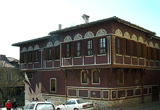 |
Bulgarian National Revival which spanned a period
from the early 18th c. to 1878. The revival process was in full
swing during the first half and especially during the third quarter
of the 19th century, the time when the Bulgarian bourgeoisie, having
gained in number, economic power and social status, was highly
susceptible to West European political and cultural influence and
was able to appreciate the significance of national enlightenment
and science. All this came as a result of the intense trade with
Europe.
And, while we know of the existence of some 390 monasteries and
settlements in which books were handcopied and most of which had
small schools during the 17th and 18th century (in these schools,
mostly set up at monasteries, instruction was given by the
synthetical method, the church psalms and basic arithmetic, though
on a smaller scale; teachers at such schools used to exercise the
pupils on a wax-coated board), in the '70s of the 19th century there
were some 2000 schools in the Bulgarian-populated lands - democratic
in character and secular in the nature of education. Textbooks, too,
began to be published as early as the first stage of the ensuing
education work. After the 'Fish Primer' was issued in 1824 (the
first textbook for elementary school), textbooks in grammar,
arithmetic, history, geography, physics and other school subjects
began to appear at various times.
During the early 19th century a unified spoken and written new
Bulgarian language started to establish itself through education,
literature and journalism. This language became prevalent in all
regions populated by Bulgarians who, towards the mid-19th century,
numbered no fewer than 4 million in Moesia, Thrace and Macedonia,
which equalled four times as much as the ruling nationality - the
Turks (according to approximate estimates, based on a 1844 household
census taken in the Balkan provinces vassal to the Porte).
The Bulgarian parishes (the sole form of organization for the
Bulgarians after their state was conquered) during the 19th century
gradually became a major institution of the Bulgarian nation,
carrying out administrative, taxation, educational and c'ultural
work. They also became schools for public life, notwithstanding
their limited authority and the conservatism of the well-to - do
Bulgarians (the chorbadjii). The trade guilds too were involved in
this upsurge and the teachers, both in the town and in the country,
stood at its helm. The movement for Bulgarian education and an
independent Bulgarian church, this 'bourgeois peaceful revolution in
the Bulgarian lands' (Dimiter Blagoev) engaged generations of
national enlighteners, some of whom fell prey to the persecution and
slander of the Patriarchy and the Ottoman rule. Such was the fate,
for instance, of the brothers Dimiter and Kostadin Miladinov, who
pioneered the collection and publication of Bulgarian folklore
(their work has today been published in ten volumes). In 1870 the
Porte officially recognized the independent Bulgarian church and
hence the Bulgarians as an independent nationality (prior to this
the Bulgarians were categorized either as Christians or Greeks).
The intellectual life of the Bulgarians in the 19th century was
influenced strongly by Russian culture. Russian scholars and public
figures placed themselves at the service of the Bulgarian revival.
The government of Russia issued grants to Bulgarian youths who were
sent to study in Russia by Bulgarian village communes and city
municipalities, school trustees and parish councils. Among those
educated in Russia were such distinguished Bulgarians as Naiden
Gerov (author of a six-volume dictionary of the Bulgarian language),
Prof. Marin Drinov, Nesho Bonchev, Lyuben Karavelov and Hristo Botev.
The Bulgarians also drew on the experience of the European
democratic movements. Quite a few Bulgarians were involved in these
movements and the liberation struggles of neighbouring peoples.
However, the struggle of the Bulgarians for political liberation
encountered many complications. Russia and the Austrian empire had,
since the end of the 16te century, been putting systematic pressure
on the Porte, directing their expansion to the Balkans. In the
meantime the economic contacts of the Ottoman empire with Western
Europe facilitated the development of productive forces on the
empire's territory and the promotion of the new, mor'e progressive
bourgeois social relations. The credits allocated to the empire by
the West European capitalist countries bound it to economic
dependency and in time the Ottoman empire became a kind of a
semi-colony and a target of the conflicting interests of the Great
Powers who spelled the course of European affairs. These conflicting
interests, the designs of the foreign powers on the possessions of
the withering Ottoman empire were impersonally known as the 'Eastern
Question'. The object of the antagonistic aspirations was very much
partial, however. In the chronically ailing empire the oppressed
nationalities were standing up for their rights, seeking ways and
means to throw off foreign domination. They also were a part of this
'Eastern Question'.
During the first half of the nineteenth century Russia dominated the
scene, becoming, by virtue of her political and military might, a
major factor in European politics. At the time Russia acted more or
less unimpeded against the Ottoman empire, and her aspirations
objectively coincided with those of the liberation struggles of the
Balkan peoples.
During the war of 1810-1811 Russian troops controlled for some time
the Bulgarian towns of Dobrich, Pleven, Razgrad, Lovech and Sevlievo.
Organizing their assistance to the Russians, the Bulgarians set up
their own People's Committee for Liberation, headed by bishop
Sophronius of Vratsa, one of the first writers of the Bulgarian
Revival. The Committee also organized a Bulgarian People's Army,
which took part in the siege of Silistra in 1811. During the war of
1828-29, when the Russian army crossed the Balkans from the Danube
on the way to Adrianople, the Bulgarians again organized themselves
to fight for liberation. The Porte relinquished its hold on some of
its possessions, albeit on the outlying ones. It granted autonomy to
Serbia in 1815 and independence to Greece in 1829. The attainment of
the political freedom of the Bulgarians, due to the country's
proximity to the capital of the empire and for a number of other
reasons, proved the crux of the Eastern question. Many Bulgarians
over this period left their native parts to settle in Russia.
After the Crimean War (1853-1856) external circumstances from the
point of view of the Bulgarian struggles for political liberation
were complicated. Russia suffered defeat. The West European
capitalist states, whose designs provided for the preservation of
the entity of the Ottoman empire, gained superiority in the
settlement of the Eastern question. From the beginning of the 19th
century the Porte launched some reforms aimed at revitalizing the
empire. A regular army was set up on the Western European model. The
spahi institution was abolished in the '30s to let the basic
producers, the farmers and artisans, settle their relationship with
central power directly through taxation, independent of their local
masters. These and other reforms that followed were, however, either
only half - way implemented or simply remained on paper. Great care
was expended only on the upkeep of a well-equipped and modernized
army.
The penetration of European capitalism into the economy of the
Ottoman empire led to a one-sided economic development within the
empire and the Bulgarian lands. Many of the workshops, whose produce
had been sold on the empire's markets all the way from Bosnia to
Egypt and throughout the Arab Peninsula, failed to keep up with the
competition and went bankrupt. The Ottoman empire became an exporter
of farm produce (cotton, wool, leather, fur, silk, etc.) to the
European markets and a consumer of a large portion of Europe's
industrial goods.
It was in these circumstances that the Bulgarians' patriarchal and
regional awareness became a national awareness. In the context of
foreign domination the structure of Bulgarian society did not become
entirely bourgeois. In the third quarter of the 19th century four
textile and two silk-spinning mills, two soap-making factories, a
salt-petre factory, a state printing house and rolling stock repair
shop, a macaroni factory, a beer and liquor breweries, a shoepolish
factory, three tanneries, six steam-operated flour mills and some
twenty more advanced water-mills went into operation on territories
populated by Bulgarians. This made a total of 25 industrial
enterprises employing no more than 750 workers. The numbers of the
working class grew also as a result of the differeritiation that
took place among the artisans and the increasing demand for wage
labour by city firms, shops and inns. According to latest research,
hired- and white-collar workers in the cities by the end of the '60s
amounted to 12 per cent. Their wages were paltry and labour
legislation non-existent.
A fair number of Bulgarians had intentions of building new factories
but they came up against insurmountable difficulties and their
capital thus went mostly into commerce or money-lending. In this way
Bulgarian society was unable to go beyond the manufacturing,
commercial and money-lending stage of capitalist development. In
this situation the individual social groups had two-way functions
-they were bound both to the old disintegrating system and to the
new economic activities opposing the old system. All strata of
Bulgarian society suffered, to a varying degree, under the burden of
foreign political oppression and were aware of the need for their
own Bulgarian state organization. For this reason patriotic
aspirations prevailed in the Bulgarian liberation movement despite
class and ideological differences. This found expression in social
charity: the well-off Bulgarians donated money for the construction
of schools and public buildings, the decoration of churches and
monasteries, the development of their native places, the erection of
water-fountains, book publication, the education of the young, etc.
By the mid-nineteenth century the Bulgarian nation already had its
own intelligentsia whose members had obtained their degrees in
various European universities and who had learned from the
experience of the other liberation movements on the continent. This
intelligentsia began to revise the traditional national virtues in
unison with the cultural upsurge of Western Europe, supplemented by
the general pan-Slavic spiritual awakening. This brought in its wake
the creation of inimitable works of Bulgarian art (particularly
during the third quarter of the 19th century, and in iconography and
church-painting as early as the beginning of the century). There
were many Bulgarians among the numerous builders, icon-painters,
woodcarvers and stone-masons who travelled to work in
Constantinople, Jerusalem and Alexandria. Upon return to their
country they constructed and decorated the tall and elegant houses,
preserved to date in Plovdiv and Koprivshtitsa. In the meantime the
first Bulgarian scholars obtained their degrees and began to work
outside their homeland, in Russia, Romania, France and other
countries. Suffice it to follow the work and progress of Spiridon
Palaouzov, Marin Drinov and Dr Peter Beron of Kotel (author of the
Fish Primer) who worked in France, building his own cosmogony-panepistemology.
The Bulgarian Revival, this 'wonder of the 19th century', as Louis
Leger called it, does not lend to a sketchy, diagrammatical
description; it cannot be conceived as the direct result of the
existing economic base, which remained but implicit. The main-spring
of the potential of the nation, elevated to a maximum, was something
different. The antipodes stood out clearly and when the
prerequisites and conditions were at hand they brought to life
titans of the mind and the cause. When a community combines its
forces to overcome the factors impeding its progress, it professes
an extraordinary affinity for the accomplishments of the preceding
generations and the surrounding world. The maxim: 'We are in time
and time is in us. We transform it and it transforms us' (Vassil
Levski) holds good in this case.
The third quarter of the century was characterized by the rapid
development of Bulgarian culture which, permeated by Renaissance,
Enlightenment and humanistic ideas, adapted modern bourgeois
conceptions of social life to regional conditions and tasks.
Most of the writers and revolutionaries of the Bulgarian National
Revival were educated in Russia, in the atmosphere and spirit of the
Russian populist intelligentsia, who fought against the autocracy
for a republic and a representative popular government. We must add
to this the direct or oblique influence of the forces opposing
national and social injustice in the European countries - the
platform of Giuseppe Mazzini which had acquired European
significance, the Italian national liberation movement headed by
Giuseppe Garibaldi, the Polish revolutionaries, the revolutionary
democratism of Hertzen, Chernishevski, Dobrolyubov and Nekrasov, of
Proudhon and Bakunin, of the First International and the example set
by the Paris Commune.
The preparations for the national liberation revolution began in the
early '60s under the guidance of Georgi Sava Rakovski (1821 - 1867).
The revolutionary actions of the time, the dispatching to Bulgaria
across r'eighbouring borders of Bulgarian revolutionary chetas did
not meet the support of the local population. The well-to-do
Bulgarians were as yet reserved and hesitant.
Relatively better prospects for the Bulgarian national liberation
movement opened up only at the end of the '60s and the early '70s
after the Austro-Prussian war (1866) and the Franco-Prussian war
(1870-1871) when the Ottoman empire lost two of its most ardent
patrons (Austria and France) and Russia rejected the restrictive
clauses of the 1856 Treaty of Paris and regained its status as a
great power. As far as Russian foreign policy was concerned,
however, the Eastern Question remained in the background during this
period, too. This made it imperative for the Bulgarians to surmount
the policy of temporization and accommodation towards Great Power
policy and turn to active revolutionary work which would bring about
the final resolution. The Bulgarian revolutionaries became aware of
this necessity in time. This is shown by the way in which the great
Bulgarian poet and revolutionary Hristo Botev (1848-1876) called for
'a revolution of the people, immediate, desperate': 'Europe and the
political circumstances grant freedom and independence only to those
who can win it alone'.
It became apparent that armed struggle was the only way out and that
the path was irreversible. It was in this spirit that an entire
generation of revolutionaries matured, whose humanism and
uncompromising patriotism, respect for equality and freedom went
hand in hand with the building of a revolutionary organization
congenial to the conditions prevailing in Bulgaria. Lyuben Karavelov,
the classic of Bulgarian prose-writing and publicism, complemented
the Balkans and in Europe from the point of view of the Bulgarian
cause, while Hristo Botev, through his poetry and dazzling publicism
elevated responsibility before the nation and mankind's freedom to
the level of a cult. Together with other Bulgarian revolutionaries
Hristo Botev enthusiastically hailed the Paris Commune and
proclaimed 'The Credo of the Bulgarian Commune'. Unlike the pioneers
of the Bulgarian Revival, who as individuals gave an impression of
timidity, Hristo Botev was one of those people who came across
powerfully with a clear-cut individuality of their own. He was also
fully aware of what the times and duty to his country demanded of
him. Reviewing what was achieved during the epoch under
consideration, literary critics place Botev on a par with such
world-renowned poets as Adam Mickiewicz and Sandor Petofi, and
rightly so.
During the decisive stage of the struggle for political liberation
there stood out the genius of Vassil Levski (1837- 1873) as an
organizer who inspired hope in the Bulgarian nation's own strength
and also took into account its possibilities of creating a military
force of its own. Twice during the 1860s he joined the Belgrade
legion (voluntary task force) which took part in operations carried
out by the Serbian government against the Turkish garrison in
Belgrade. A professional revolutionary, Vassil Levski toured the
country on various occasions. During one of these tours, in 1869, he
distributed propaganda materials both among Christians and Muslims.
Vassil Levski advanced a new tactics of revolutionary struggle which
consisted in carrying out a purposeful and prolonged political and
organizing work among the Bulgarians within the movement for
national education and for an independent Bulgarian church, a
movement that had developed during the preceding decades. Instead of
engaging in scattered and sporadic actions depending on the f.oreign
political situation, he advocated the establishment of a political
structure and military organization backed up by the mass of the
people. Levski himself took up the difficult task setting up as he
did a network of local revolutionary committees, a secret postal
service and security guard whose leadership was elective and
subordinate to a single centre based in the town of Lovech. He drew
up the Statutes of this Internal Revolutionary Organization which
was approved by the General Assembly of the Bulgarian Central
Revolutionary Committee headquarters in Bucharest. The Statutes
indicated the way of casting off tyranny and outlined the
administration of the future free Bulgarian state.
In setting up the revolutionary organization Vassil Levski proceeded
from the strictly established principles which he further developed
and upheld during his practical revolutionary activity: democratic
centralism, internal organizational discipline, collective method of
work, criticism and self-criticism in the relations between his
followers. According to Levski, only 'sensible, persevering,
fearless and magnanimous people' were to be entrusted with
responsible work. The Apostle of Freedom, as he was called by his
contemporaries, was categorical: if one of these qualities was
absent, the organizer of the 'people's work' could harm the cause.
Respect for the rights and freedoms of every individual was, to his
mind, a sacred law dictated by the imperatives of the time. At the
height of his activity, in early 1873, Levski was caught and hanged
in Sofia. His work was continued by his adherents in the four
revolutionary districts that had taken shape in the Bulgarian lands.
After the settlement of policy problems and some reshuffles the
Central Revolutionary Committee organized an armed uprising by the
Bulgarians on both sides of the Balkan Range, in the region of
Sredna Gora Mountain and in the northern parts.of the Rhodopes
against the oppressors. This was the April uprising of 1976. |
|
|
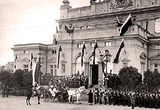 |
Third
Bulgarian State |
|
|
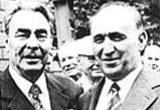 |
People's Republic of Bulgaria |
|
|
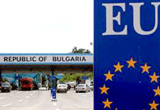 |
Bulgaria Today |
|
|
|
|
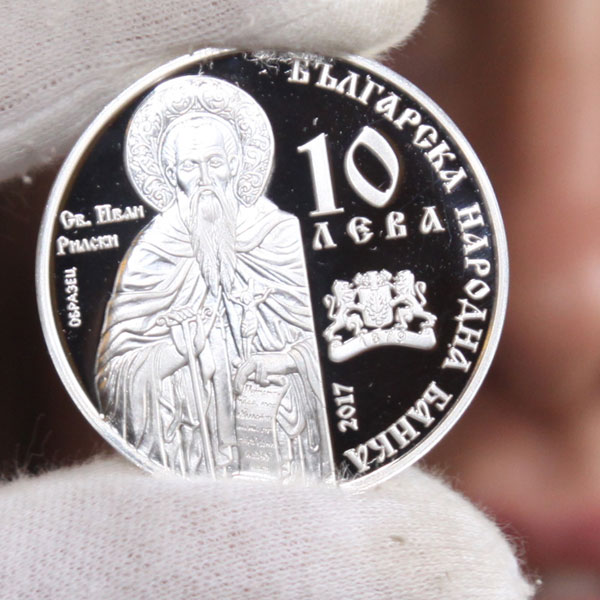 |
2017 RILA MONASTERY
.925 Silver 23.33 gm.
Official Mintage: 3,000 |
|
|
|

2017 150 YEARS SINCE THE CONSTRUCTION OF THE KOLYO FICHETO BRIDGE NEAR BYALA
.925 Silver 23.33 gm.
Expected mintage: 0 |
|
|
|

How much is my Bulgarian coin worth?
You can find an approximate answer HERE |
|
|


|

2015 130 YEARS OF THE UNIFICATION OF BULGARIA
.925 Silver
Mintage: 3,000 |
|
|
|






